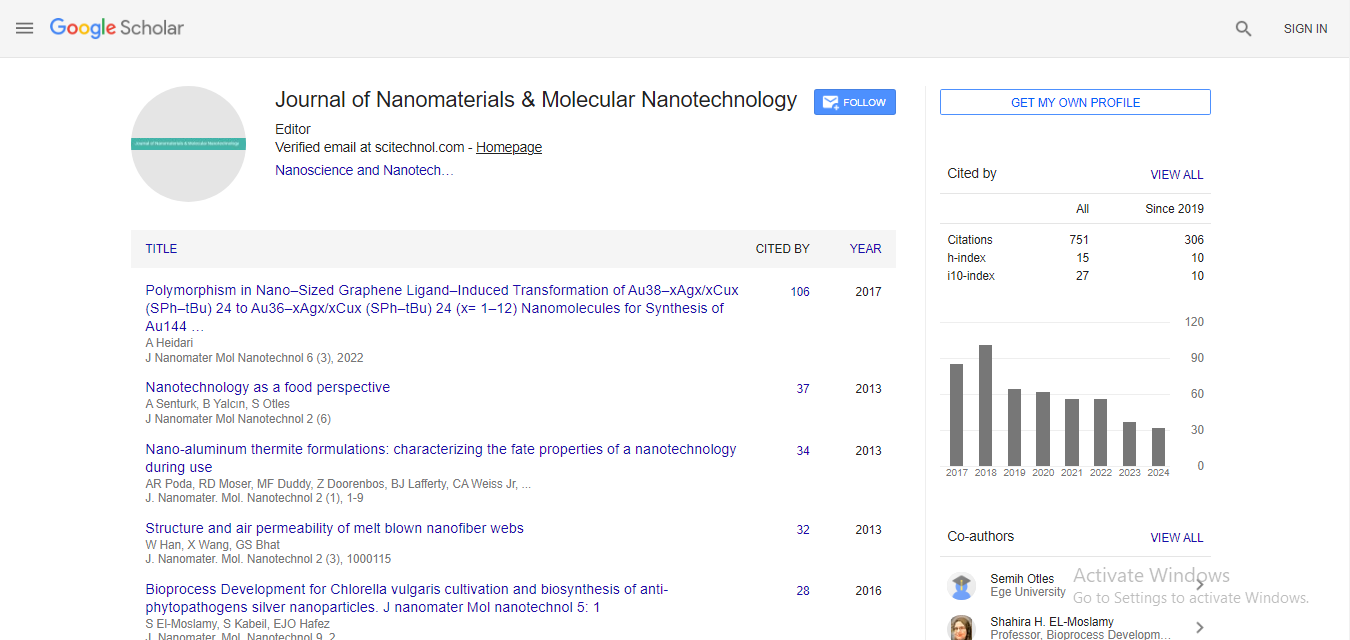Opinion Article, J Nanomater Mol Nanotechnol Vol: 13 Issue: 6
Nanoethics and the Future of Autonomous Nanobots: Safety, Control and Governance
Shuhui Cai*
1Department of Materials Science, Ocean University of China, Qingdao, China
*Corresponding Author: Shuhui Cai,
Department of Materials Science, Ocean
University of China, Qingdao, China
E-mail: Cai.shu451@ouc.cn
Received date: 22 November, 2024, Manuscript No. JNMN-24-156137;
Editor assigned date: 25 November, 2024, PreQC No. JNMN-24-156137 (PQ);
Reviewed date: 09 December, 2024, QC No. JNMN-24-156137;
Revised date: 16 December, 2024, Manuscript No. JNMN-24-156137 (R);
Published date: 24 December, 2024, DOI: 10.4172/2324-8777.1000442
Citation: Cai S (2024) Nanoethics and the Future of Autonomous Nanobots: Safety, Control and Governance. J Nanomater Mol Nanotechnol 13:6.
Description
Nanotechnology has progressed from a theoretical concept to a rapidly advancing field with real-world applications, particularly in the development of autonomous nanobots. These microscopic robots, capable of performing tasks at the molecular level, hold immense potential for a wide range of applications, from targeted drug delivery to environmental cleanup. However, their potential raises significant ethical questions related to safety, control and governance. As these technologies evolve, it is essential to examine the ethical frameworks that will guide their development and deployment, ensuring that their benefits are realized without compromising human welfare, security and environmental integrity. Autonomous nanobots are self-operating, nanoscale robots that can perform tasks independently, often in environments that are beyond the reach of human capabilities. Unlike traditional machines, these nanobots can navigate through the human body, detect diseases and deliver precise treatments to specific cells or tissues. In addition to their medical applications, they could be employed for environmental remediation, such as breaking down pollutants at the molecular level, or in industrial settings for precision manufacturing. The defining feature of autonomous nanobots is their ability to make decisions and carry out actions based on pre-programmed algorithms or adaptive systems that enable them to interact with their environment. While these capabilities offer transformative potential, they also introduce significant ethical concerns regarding their safety, governance and societal impact.
One of the primary ethical issues associated with autonomous nanobots is safety. While their small size and advanced functionality make them highly effective for medical treatments, they could also pose sudden risks if not properly designed, controlled and monitored. There is also the possibility of "runaway" nanobots, where the autonomous systems are unable to self-regulate, leading to uncontrolled replication or aggression. This scenario, although highly uncertain, draws parallels to the out of control nanotechnology, where self-replicating nanobots consume all available matter and ultimately destroy the environment. While current technologies are far from this level of sophistication, the fear persists as autonomous systems become more advanced.
As autonomous nanobots become more complex, control mechanisms will be essential to ensure that they function within predefined ethical boundaries. One of the key ethical concerns surrounding autonomous systems is the loss of human control. While autonomous nanobots are designed to operate independently, there must be mechanisms in place for human oversight and intervention if necessary. This could include remote monitoring, fail-safes, or the ability to deactivate or reprogram nanobots should they deviate from their intended function. Clear accountability structures must be established to ensure that there is always someone responsible for the actions of these technologies.
The development of autonomous nanobots presents challenges for existing regulatory frameworks. Given their nanoscale size and the complexity of their potential applications, it is difficult to regulate them effectively using current standards. Therefore, comprehensive governance strategies must be established to ensure responsible development and deployment of these technologies.
Given the global nature of nanotechnology development, international cooperation and regulation are essential. Institutions such as the World Health Organization (WHO), International Atomic Energy Agency (IAEA) and United Nations Educational, Scientific and Cultural Organization (UNESCO) could play important roles in establishing global standards for the safe and ethical development of autonomous nanobots. These regulatory bodies must also work to prevent unethical or unsafe uses of the technology by establishing guidelines for both research and industrial applications.
Researchers and developers working on autonomous nanobots must be held to strict ethical standards. Institutional Review Boards (IRBs) or ethics committees should be involved in evaluating nanobot research projects, particularly those that involve medical or environmental interventions. Ethical guidelines should address issues such as informed consent (in the case of human testing), transparency in research and ensuring that the technology does not disproportionately affect vulnerable populations.
Conclusion
Autonomous nanobots represent one of the most exciting boundaries of nanotechnology, offering transformative potential for medicine, environmental sustainability and industry. Ensuring the responsible use of these technologies will require strict safety standards, effective control mechanisms and international regulatory frameworks. As nanotechnology continues to evolve, it is imperative that we integrate ethical reflections into the research and development process to avoid unexpected consequences and to guarantee that the benefits of autonomous nanobots are realized for all of humanity.
 Spanish
Spanish  Chinese
Chinese  Russian
Russian  German
German  French
French  Japanese
Japanese  Portuguese
Portuguese  Hindi
Hindi 



